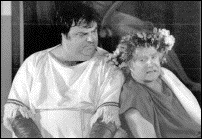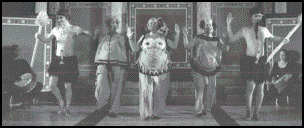 FEATURES ROMAN STAGINGS:
FEATURES ROMAN STAGINGS:
Mission to Malibu:
Ancient Theatre at the Getty Museum

The cast of Casina in their final tableau.
by Richard C. Beacham
School of Theatre Sudies
University of Warwick
Coventry CV4 7AL
England
E-mail: tsrai@snow.csv.warwick.ac.uk
Actors and directors are reluctant to tackle works which are relatively 'untested', but, since the imitation of successful productions (usually the same small sample of a much larger body of ancient plays) soon turns stale, producers quickly return to other, more 'reliable' works to stock their repertoire. As a result, most ancient drama -- including many works of the greatest artistry and theatrical potential -- has not yet benefited from the type of systematic exploration through performance which has so enormously enhanced our understanding and enjoyment of the works of Shakespeare, and particularly through the pioneering work at the RSC Swan theatre, his contemporaries.
Recently the J. Paul Getty Museum in Malibu California presented professional productions of two ancient works by authors rarely (if ever) performed, and in doing so provided an early and intriguing example of what could in the future become a formal programme of investigative performance of ancient drama under its auspices. Five years ago I was invited by the Museum's Curator of Antiquities, Dr. Marion True, to describe my research into the staging (both ancient and modern) of Roman drama, which had led to a series of productions at Warwick University upon a replica Roman stage derived from the evidence provided by Pompeiian wall paintings. In September of 1992 I returned to give a lecture at the Museum on the subject, and to participate in discussions of future projects inspired by the markedly successful presentation at that time of a dramatised version of portions of Oliver Taplin's translation of the Odyssey. Following these, Dr. True and her colleague Dr. Hamma decided to undertake a full-scale production of two ancient comedies: Menander's Woman from Samos, translated by J. Michael Walton, professor of theatre at Hull, and my translation of Plautus' Casina. We also decided to present these upon a replica stage based on Pompeiian frescoes which would be constructed in the inner peristyle of the Getty Museum, itself an exquisite replica of a Roman villa buried at Herculaneum by Vesuvius in A.D. 79.
 Olympio (Robert Machray) and Lysidamus (Larry Randolph) make plans to 'win' Casina.
Olympio (Robert Machray) and Lysidamus (Larry Randolph) make plans to 'win' Casina.
The Museum decided to present these plays in conjunction with a major exhibition of a superb private collection of antiquities, the Fleischman Collection, which contains many theatrical objects and which was scheduled to open in October. The plays would in effect provide further suggestive examples of 'artifacts' generated by the same culture which had produced those dis- played in the exhibition. Professor Walton and I were invited to participate in the entire process of planning and rehearsal, working closely with the production's director, Professor Michael Hackett of UCLA.
While pursuing a related research project for several months during the winter as a visiting scholar at the Getty Center for the History of the Arts and Humanities, I assisted during the initial stages of the project and was able to oversee the design and decor of the stage structure. Shortly after auditions were completed in August, Professor Walton arrived, and, together with the director, we began rehearsals. We had cast both plays using the same ensemble, which allowed us in several cases (by for example having the same actor play the 'father' in both plays) deftly to convey the very significant contrasts in characterisation between Menandrian and Plautine comedy, as well, of course, as the quite different use of language. This however, demanded considerable versatility from the performers, and in rehearsal much of the most interesting work involved watching and advising the actors as they played with the stylistic demands of each role.
 Olympio (Robert Machray), 'Casina' (John Mathews) and Lysidamus (Larry Randolph) anticipate their 'wedding night.'
Olympio (Robert Machray), 'Casina' (John Mathews) and Lysidamus (Larry Randolph) anticipate their 'wedding night.'
It is often asserted that American actors tend to 'play themselves', and are resistant to formulating the strongly stylised (and anti-naturalistic) roles which 'classical' drama frequently demands. But (in part because we had cast our plays after sifting through several hundred potential actors), this proved a surmountable problem: the greater challenge lay in persuading the cast to speak the often syntactically complex, and, in the case of the Casina, frequently rhyming language of the translation without attempting to 'naturalise' it. Several of the actors later remarked that for them one of the most demanding and valuable aspects of the project was the opportunity to perform plays of a type which, both dramaturgically and linguistically, they had never before encountered.
 Chorus of ithyphallic satyrs
Chorus of ithyphallic satyrs
The rehearsal situation -- indeed, the entire project -- was challenged by the inherent difficulty of a director potentially vexed by the presence in Professor Walton and me of two surrogate playwrights, who moreover, were ancient theatre scholars with considerable practical staging experience. This demanded more than a little tact on all sides, which by and large we managed -- although not without some lively discussions and a degree of compromise. A related problem was that of ensuring that due weight be given by members of the production and technical team and particularly those responsible for the set construction, decoration, costumes and props, to the scholarly dimension of the project. Their natural inclination as pragmatic theatre practitioners was to conceive of the affair as 'show- business as usual', while ours was to balance the need to test and extend our understanding of the staging potential of the ancient texts and replica set while avoiding the perils of antiquarianism.
 Olympio (Robert Machray) describes his session with Casina to Myrrhina (Loretta Devine), Cleostrata (Hope Alexander-Willis) and Pardalisca (Kath Kinney.) The burden of managing such concerns was more than compensated for by the benefit -- indeed, at times the pure joy -- of seeing the plays brought vividly to life at the hands of skilled professionals supported by a benevolent institution able to provide ample resources: an experience rare indeed for anyone used to the perpetual penury which is generally the lot of arts-based scholarship. Day by day the plays were probed and shaped by experienced actors who, untroubled by arcane questions of philology as such, directly responded to the staging implications of the characters, emotion, humour, and actions which they encountered in enacting the texts. Repeatedly this preoccupation with what in its essence was projecting the text into both emotional and literal space led them to raise practical questions or offer advice which in turn cast light upon matters of translation and textual interpretation. This process of experiment and revelation was for both Professor Walton and me intensely intriguing and rewarding; for the actors too the situation was unusually stimulating in the opportunity it provided directly to question and discuss a classic text and its context line by line with those 'responsible' for it.
Olympio (Robert Machray) describes his session with Casina to Myrrhina (Loretta Devine), Cleostrata (Hope Alexander-Willis) and Pardalisca (Kath Kinney.) The burden of managing such concerns was more than compensated for by the benefit -- indeed, at times the pure joy -- of seeing the plays brought vividly to life at the hands of skilled professionals supported by a benevolent institution able to provide ample resources: an experience rare indeed for anyone used to the perpetual penury which is generally the lot of arts-based scholarship. Day by day the plays were probed and shaped by experienced actors who, untroubled by arcane questions of philology as such, directly responded to the staging implications of the characters, emotion, humour, and actions which they encountered in enacting the texts. Repeatedly this preoccupation with what in its essence was projecting the text into both emotional and literal space led them to raise practical questions or offer advice which in turn cast light upon matters of translation and textual interpretation. This process of experiment and revelation was for both Professor Walton and me intensely intriguing and rewarding; for the actors too the situation was unusually stimulating in the opportunity it provided directly to question and discuss a classic text and its context line by line with those 'responsible' for it.
When rehearsals moved into the Museum and onto the massive stage erected there, everyone became viscerally aware of how such a grand and refined set- ting must condition the reaction of our audience. Both plays were examples of an exuberant comic impulse, which particularly in the case of the Plautus, was largely unfettered by the sort of decorous and respectful attitude deemed appropriate to a museum. Of course, many of the artifacts there themselves exemplified the love of sensual pleasure so evident in antiquity. However, it was one thing to contemplate these safely tucked away as Grecian urns in glass cases or statues behind restraining barriers, and quite another to be confronted (in our production) by a polymorphously perverse chorus of ithyphallic satyrs cavorting before an incredulous Los Angeles audience, which, although sophisticated, did not in general have a wide experience of theatre -- certainly not of the sort now dreamed before them at the Getty. A similar factor arose from the plays' language, which (as the Museum advised in its publicity), was 'earthy' and suitable for 'mature audiences'.
On the other hand, the venue and occasion also encouraged the audience to experience a piece of 'total theatre', since as one review noted, 'when you enter the grounds and see the villa's long colonnade, reflecting pools and gardens set against the deep blue evening sky, the effect is magical -- like stepping into a Maxfield Parrish painting.' In any case, for whatever combination of factors, the production proved extremely popular, playing until the end of October before capacity audiences, which (without the need for any gimmicky displacement of the scripts) easily responded to the plays' innate theatrical efficacy. It was a profoundly moving and instructive experience to observe modern theatre-goers still laughing after all these years at the same jokes, situations, and characters that those distant ancient audiences had enjoyed over two thousand years ago. And it left one more convinced than ever, of the rewards and discoveries awaiting those who dare to venture into the 'lost continent' of ancient theatre; and there could be no institution more ideally equipped for that mission, than the Getty Museum, which as the reviewer for the L.A. Times gratifyingly concluded, 'should consider keeping a permanent resident company devoted to performing classics'.
Professor Richard Beacham
School of Theatre
University of Warwick
E-mail: tsrai@snow.csv.warwick.ac.uk
Photos Courtesy of the J. Paul Getty Museum
Kenneth Hamma's description of the project.
Judith Maitland's production of Casina.
Mary-Kay Gamel's review of the Getty productions (Didaskalia).
Marianne McDonald's review of the Getty productions (Didaskalia 1.5).
